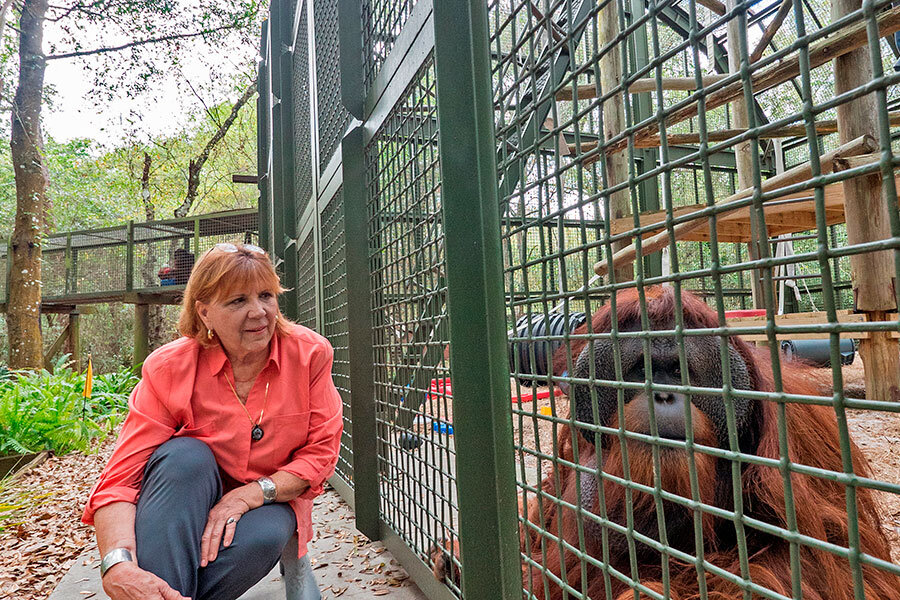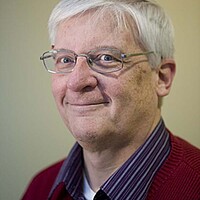Rescued chimpanzees and orangutans: This woman’s lifework is caring for them
| Wauchula, Fla.
Patti Ragan skillfully maneuvers a golf cart along narrow twisting paths through the heavily wooded Center for Great Apes. Around us loom live oaks and magnolias, bamboo groves, and fruit-bearing banana and mango trees that shield us from the sun on a warm late-winter day in central Florida.
She stops in front of a huge “habitat,” an immense, more than 40-foot-high cage.
“There’s Christopher. Hi, Chrissy boy,” she shouts. We jump out of the cart and approach a 270-pound orangutan, a giant pile of ruddy orange fur squatting peacefully near the sturdy fencing. She offers him a piece of fresh fennel, one of his favorite treats. “He’s very laid-back,” she says.
As we zip around to other habitats – eight for orangutans and eight for chimpanzees – it’s clear that Ms. Ragan quickly recognizes each resident. When we stop at one of the chimpanzee habitats, she gives a short history of the ape we’re meeting.
“Chipper is a special case. He’s about 44 now,” she says. “He was a wild-caught baby who worked in the circus until he was about 10.” When he became too large and dangerous to control, he was sent to a biomedical research facility. Later “he ended up going to several roadside zoos. We took him about 16 years ago with his buddy, Butch.”
Ragan has made it her lifework to care for these great apes rescued from laboratories, pet owners, and the entertainment industry across the United States. The center she founded nearly 25 years ago has become in part a rehabilitation facility and in part a nursing home for apes, which can live 60 years or more in captivity.
Ragan cares for these “intelligent animals,” she says, for no other reason than they need it.
The sanctuary, she makes clear, is neither a zoo nor a research facility. The rules are strict: no breeding of apes, no buying or selling of apes. No research is allowed except what is learned from nonintrusive observation of their behaviors. And no visitors are permitted except by special arrangement, such as school groups.
Instead of being forced to act like and perform for humans, the residents here finally live as apes.
While people at the center provide care (about 26 staff members and more than 50 volunteers), they stay in the background; workers don’t enter a habitat when an ape is present. For the first time for many of these orangutans and chimpanzees, their main social contacts are with their own species.
Because they haven’t lived on their own, and weren’t raised by their mothers for the usual six or seven years, they can’t be returned to the wild. They wouldn’t know how to survive – and wouldn’t be accepted by wild apes. In addition, many of them are elderly, and nearly all deal with problems caused by past emotional or physical abuse.
The center has become a model for ape sanctuaries across the US, eight of which are full members of the North American Primate Sanctuary Alliance (NAPSA), which Ragan helped to found. It’s the only sanctuary in North America that offers a home to orangutans.
Praise from Jane Goodall
World-famous primatologist Jane Goodall, who has visited the Center for Great Apes, lauds Ragan’s “deep commitment and passion for the apes” and serves as an honorary director.
Gloria Grow, cofounder and director of the Fauna Foundation, a sanctuary for chimpanzees and other animals near Montreal, has known Ragan for two decades. “She’s like our queen,” Ms. Grow says. If anyone wants to start a sanctuary, “the one place you send those people is to Patti Ragan, because that’s the place you want to go to see how you should do it.”
And the praise keeps coming. “Patti is somewhat of a legend, I would say,” says Erika Fleury, NAPSA’s program director based in San Francisco. “She’s someone I look up to a lot.... She is highly respected. And she’s known as an expert in the care of great apes.”
Ragan’s interest in apes began when, as a young woman, she volunteered to travel to Borneo to help scientists research orangutans. She also volunteered at a Miami zoo and played nurse to a baby orangutan that had been separated from its mother.
Eventually she decided her purpose in life was to care for great apes that had spent their lives in captivity. She searched for several years before finding this property near Wauchula, Fla. After selling the temp agency she owned, she bought a few acres, planning to house five residents. Today her nearly 50 great apes (and more are on the way) live on about 120 acres of property, much of it donated by supporters. Just this month, five new orangutans arrived.
One distinctive feature of the sanctuary is its 1-1/2 miles of enclosed, elevated walkways that allow the apes to wander freely to habitats around the property. Other ape sanctuaries have copied the idea, though on a smaller scale, as has the Philadelphia Zoo, Ragan says.
She hopes she’s playing a part in changing attitudes toward great apes. “They’re intelligent animals, [but] they’re not pseudo-humans,” she says. “They are adorable, but they can grow very strong [about four times as strong as an adult human].... They need companionship, and we can’t be companions when they get too strong for us.”
One misconception about chimpanzees is that they’re small and childlike. But adults can weigh as much as 180 pounds and can be powerful and dangerous. Usually infants are seen on TV or in greeting cards or movies.
Bubbles the chimpanzee
Perhaps the center’s most famous resident is the chimpanzee Bubbles, formerly the pet of pop singer Michael Jackson.
“He’s a very sweet boy and a very big boy,” Ragan says. “He was with Michael until he was about 6 or 7, and then Michael realized, as most people do, that he couldn’t safely handle Bubbles or have his children be around him.”
People frequently misread chimpanzees’ emotions. “When chimpanzees show all their teeth, it looks like a human smile, but it’s really an expression of fear,” says Cathy Willis Spraetz, president and chief executive officer of Chimp Haven in Keithville, La., a designated sanctuary for chimpanzees formerly used in federally funded research.
Another chimpanzee at the Center for Great Apes is Knuckles, who has been diagnosed with cerebral palsy. Ragan employs a therapist who works with Knuckles in his own special enclosure. She carefully chooses one of the older, docile apes to provide him with companionship.
“Patti has this devotion to Knuckles,” Ms. Spraetz says. “Most situations call for Knuckles to be euthanized because he can’t defend himself within a social group.... To me this just speaks volumes about the kind of person she is and her care and devotion to the animals.”
One of her many skills has been the way she negotiates with pet owners or people in the entertainment industry to persuade them that life in a sanctuary is the best thing for their apes. She doesn’t condemn owners or dwell on any mistreatment the animals may have endured.
“It’s very difficult to get the apes away from people who’ve had them in their backyard or in their houses 20, 30, 40 years sometimes,” says Grow of the Fauna Foundation. But Ragan’s gentle approach works. “Patti has done a brilliant job of that,” Grow says. “It’s quite a skill.”
• For more, visit CenterforGreatApes.org.
How to take action
UniversalGiving helps people give to and volunteer for top-performing charitable organizations around the world. All the projects are vetted by UniversalGiving; 100 percent of each donation goes directly to the listed cause. Below are links to three groups aiding animals:
In Defense of Animals – Africa provides sanctuary for orphaned chimpanzees in Cameroon while supporting habitat protection and other measures. Take action: Help protect chimpanzees.
Pandas International works to ensure the preservation and propagation of the giant panda. Take action: Donate money to this organization.
San Francisco SPCA (Society for the Prevention of Cruelty to Animals) saves animals, administering care and lobbying for their welfare. Take action: Sponsor a foster kitten or puppy.






